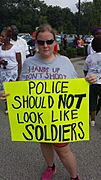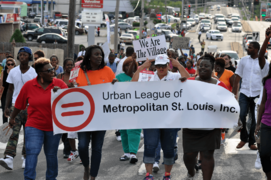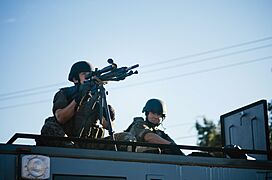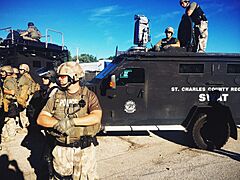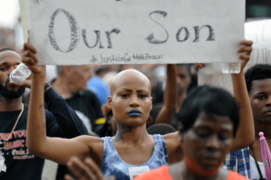Ferguson unrest facts for kids
Quick facts for kids Ferguson unrest |
|
|---|---|
| Part of the Black Lives Matter movement and reactions to the Killing of Michael Brown |
|
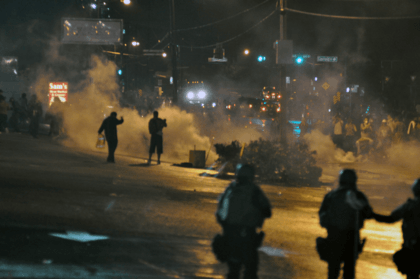
Police officers using tear gas on protesters
|
|
| Date | First wave: August 9–25, 2014 Second wave: November 24 – December 2, 2014}} Third wave: August 9–11, 2015 |
| Location |
Ferguson, Missouri, U.S. and St. Louis, Missouri, U.S.
|
| Caused by | First wave: Killing of Michael Brown Second wave: Darren Wilson not indicted Third wave: Anniversary of shooting |
| Methods | Widespread rioting, vandalism, looting, arson, and gunfire. |
| Casualties | |
| Injuries | 10 members of the public injured 6 police officers injured |
| Arrested | 321 members of the public |
The Ferguson unrest (sometimes called the Ferguson uprising, Ferguson protests, or the Ferguson riots) was a series of protests and riots which began in Ferguson, Missouri on August 10, 2014, the day after the fatal shooting of Michael Brown by FPD officer Darren Wilson. The unrest sparked a vigorous debate in the United States about the relationship between law enforcement officers and Black Americans, the militarization of police, and the use-of-force law in Missouri and nationwide. Continuing activism expanded the issues by including modern-day debtors prisons, for-profit policing, and school segregation.
As the details of the shooting emerged, police established curfews and deployed riot squads in anticipation of unrest. Along with peaceful protests, there was a significant amount of looting and violence in the vicinity of the site of the shooting, as well as across the city. The unrest continued on November 24, 2014, after a grand jury did not indict Officer Wilson. It briefly flared again on the first anniversary of Brown's shooting. The Department of Justice (DOJ) concluded that Wilson shot Brown in self-defense.
In response to the shooting and the subsequent unrest, the DOJ conducted an investigation into the policing practices of the Ferguson Police Department (FPD). In March 2015, the DOJ announced that they had determined that the FPD had engaged in misconduct against the citizenry of Ferguson by, among other things, discriminating against African Americans and applying racial stereotypes in a "pattern or practice of unlawful conduct." The DOJ also found that the Ferguson city council relied on fines and other charges generated by police for funding municipal services.
Background
Michael Brown, an 18-year-old African-American male, was killed during an encounter with Officer Darren Wilson. Officer Wilson arrived after a robbery and assault was reported at a nearby convenience store. The caller described the accused (later identified as Michael Brown from security cameras). Officer Wilson's account was that after seeing Brown and Brown's friend Dorian Johnson walking home in the middle of the street he asked them to walk on the sidewalk instead. When they refused Wilson noticed that Brown's shirt and a box of cigarillos he was holding matched the description from the robbery call, and suspected Brown and Johnson as being involved. When he attempted to question Michael Brown, he was attacked. There was a struggle, Brown attempting and almost succeeding in gaining possession of Officer Wilson's weapon. Due to the struggle, the weapon discharged, slightly wounding Brown, who then fled. Wilson gave brief chase firing upon Brown, ultimately killing Brown when Brown turned to confront him and, upon Wilson's account, charged at him. The officer was a 28-year-old white male Ferguson police officer. After several months of deliberation, a grand jury decided not to indict Officer Wilson for any criminal charges in relation to the incident.
The police response to the shooting was heavily criticized, as was the slow rate of information making its way out to the public. Many of the documents received and reviewed by the Grand Jury were released when the grand jury declined to indict Officer Wilson.
Gallery
-
St. Charles County SWAT team at Ferguson. The device on top of the armored vehicle is a type of directed-energy weapon called an LRAD


